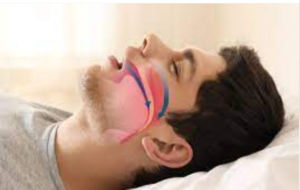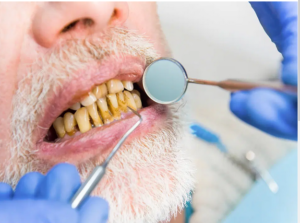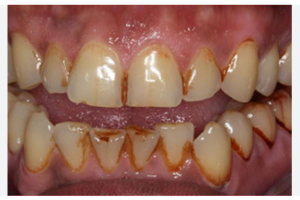INTRODUCTION
Halitosis is a term used to describe noticeably unpleasant odor exhaled in breathing. It is a general term used to describe the unpleasant breath regardless of its sources, oral or non-oral. Whereas, oral malodor is the term especially used to describe the odor from the oral cavity. Halitosis which is in synonym with breath malodor, foul breath and Fetor oris or simply bad breath affects a large proportion of population which may cause a significant social or psychological handicap to those suffering from it. This common disease has been ignored for too long by periodontologists even though the most common cause is related to the micro biota of the subgingival areas and the related tongue coating. The intensity of the bad breath differs during the day, (which may be due to the stress or fasting), eating certain foods (such as garlic, onions, meat, fish and cheese), smoking and alcohol consumption. Because the mouth is dry and inactive during the night, the odor is usually worse upon awakening (morning breath). Bad breath may also be persistent (chronic bad breath) which is a more serious condition, affecting at least 25% of population in varying degrees.

CLASSIFICATION OF HALITOSIS
Genuine Halitosis
Physiologic halitosis
Pathologic halitosis Oral
Extraoral
Is an obvious malodor, with intensity beyond socially acceptable level is perceived.
Pseudo-halitosis
Obvious malodor is not perceived by others, although the patient stubbornly complains of its existence,condition can be improved by counselling and simple oral hygiene measures.
Halitophobia
After treatment for genuine halitosis or pseudo-halitosis, the patient persists in believing that he/she has halitosis.
ETIOLOGY
At least 90% of all malodor originates from the oral cavity, whereas, the remaining 10% has systemic or normal causes. Oral malodor is commonly the result of microbial putrefaction of food debris, cells, saliva and blood within the oral cavity. In particular, proteolysis of proteins to peptides and amino acids takes place. The resultant substrates with free thiol groups such as cystein and reduced glutathionine, rises to Volatile Sulfur Compounds (VSC’s), which are malodour substances. The most common physiological and pathological causes of halitosis are discussed below:
Causes for Physiologic Halitosis
a. Mouth breathing.

b. Medications.

c. Aging and poor dental hygiene.

d. Fasting/starvation.

e. Tobacco.

f. Foods (onion, garlic, etc.,) and alcohol.

Causes for Pathologic Halitosis Oral and other contributing factors such as:
a. Periodontal infection: Odor from subgingival dental biofilm. Specific diseases like Acute Necrotizing
Ulcerative Gingivitis and Pericoronitis.
b. Tongue coating harbors microorganisms.
c. Stomatitis, Xerostomia. d. Faulty restorations retaining food and bacteria.
e. Unclean dentures.
f. Oral pathologic lesions like oral cancers, candidiasis.
g. Parotitis, cleft palate.
h. Aphthous ulcers, dental abscesses.
Systemic and Extra-oral factors include:
a. Nasal infections like Rhinitis, Sinusitis, Tumors and foreign bodies.
b. Diseases of Gastrointestinal tract (GIT) like Hiatus hernia, carcinomas, GERD (Gastroesophagal Reflux Disorder).
c. Pulmonary infections like Bronchitis, Pneumonia, Tuberculosis, and Carcinomas.
d. Certain hormonal changes that occur during
Ovulation, Menstruation, Pregnancy and Menopause. e. Systemic diseases like Diabetes Mellitus, Hepatic failure, Renal failure, Uremia, Blood dyscrasias, Rheumatologic diseases, Dehydration and Fever, Cirrhosis of liver.
DIAGNOSIS OF HALITOSIS
a. Review of Medical, Dental and Personal history.
b. Clinical examination:
i. Intraoral examination
i. Tongue coating.
ii. Evidence of mouth breathing.
iii. Xerostomia: Dry mucosa.
iv. Other oral causes.
Complete Periodontal examination
i. General personal care, state of oral hygiene.
ii. Probing for attachment levels, probing depths (Periodontal status). i. Evidence of neglect; past history of dental
hygiene care.
c. Measurement of oral malodor:
Patients should be instructed not to eat, chew, rinse or smoke for at least two hours before examination. Patients who are on antibiotics should be seen 2 weeks after discontinuation of medicines. The tests used to detect halitosis are as follows:
i. Subjective organoleptic method: This has been used as a bench mark for oral malodor measurement.
ii. Gas chromatography: In order to assess oral malodor objectively, a portable industrial monitor has been developed. These machines are specifically designed to digitally measure molecular levels of the three major Volatile Sulfur Compounds (VSC) in a sample of mouth air (hydrogen sulfide, methyl mercaptan and dimethyl sulfide). It is accurate in measuring the sulfur components of the breath and produces visual results in graph form via computer interface
iii. Halimeters: These machines measure the level of sulfide gas found in a persons breath. But it has certain drawbacks in clinical applications, some of the common sulfides such as mercaptan are not easily recorded and can be misrep- resented in test results. The Halimeter is also very sensitive to alcohol, so one should avoid drinking alcohol or using alcohol-containing mouthwashes for at least 12 hours prior to being tested.
iv. BANA Test (Benzoyl-d, L-arginine-naphthylamide): Some of the bacteria like P. gingivalis, T. denticola and B. forsythus produce waste products that are quite odiferous and as a result contribute in causing bad breath. These bacteria in question have the characteristic of being able to produce an enzyme that degrades the com- pound benzoyl-d, L-arginine-naphthylamide. When a sample of patients saliva that contains these bacteria is placed within the BANA testing compound they cause it to breakdown. As a result of this degradation the test compound changes its color indicating a positive reaction.
v. Chemiluminescence: This test involves mixing a sample containing sulfur compound (VSC’s) with the mercury compound and the resultant reaction causes fluorescence. This test is highly sensitive as it can measure even the low levels of sulfur compounds in the sample, which is in contradiction to testing with a halimeter.
TREATMENT AND MANAGEMENT OF ORAL MALODOR
Treatment of oral malodor is a step-by-step problem solving procedure. Before commencing the treatment a clinician must determine the source of malodor. The simplest way to distinguish oral from non-oral origin is to compare the smell from mouth and nose. If the origin is nasal or due to any other medical etiology they must be referred to a concerned specialist. The odor gene- rating from the mouth often requires dental treatment. There are no standard and accepted protocols for the treatment of oral malodor, however, the possible protocols contains the basic elements including standard dental and periodontal treatment.
For genuine halitosis with oral causes the treatment is as follows:
a. Reduction of anaerobic load by improving oral hygiene and periodontal health through basic dental care, if necessary incorporate advanced hygiene
methods including oral irrigation and sonic or ultrasonic tooth brushes. b. If oral malodor persists in spite of adequate con- ventional oral hygiene, tongue brushing should be
advised.
c. Chemical reduction of oral microbial load includes rinsing or gargling with an effective mouthwash. One way to treat oral malodor associated with periodontitis is to combine regular periodontal treatment and a chlorhexidine mouth rinse. However, their long-term effect remains to be determined.
d. Another treatment strategy for oral malodor is conversion of volatile sulfur compounds by using various metal ions. Zinc (Zn++) is an ion which bonds to the twice negatively charged sulfur radicals to reduce the expression of VSC’s. Halita™ is a new solution containing 0.05% Chlorhexidine, 0.05% Cetyl pyridium chloride (CPC) and 0.14% zinc lactate with no alcohol has been more efficient than 0.2% Chlorhexidine formulation in reducing the VSC levels. The special effect of Halita may result from the VSC conversion ability of zinc, besides its antimicrobial action.
SUMMARY
Halitosis affects a large proportion of population and may cause a significant social or psychological handicap to those who are suffering from it. Oral malodor can also reveal important diseases, if it can be analyzed accurately. VSC in periodontal pockets might be used as a predictor of periodontal diseases and also to monitor therapy sites. However, current available tools/tests are not applicable for achieving these goals due to lack of accuracy and objectivity.
The dental research community has long since ignored the subject of oral malodor. Recently, along with the growing public and media interest in oral malodor, dental professionals are becoming more aware of this problem. Let us hope that future research will overcome the problems related to diagnosing and treating oral malodor effectively.